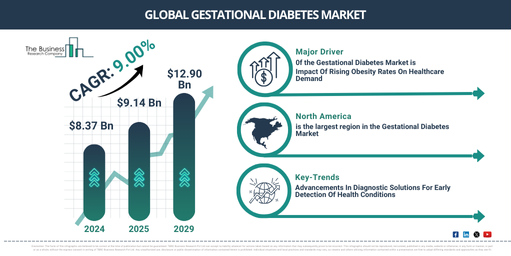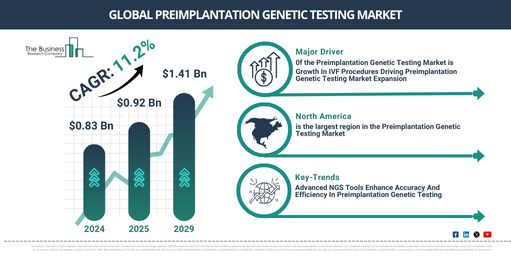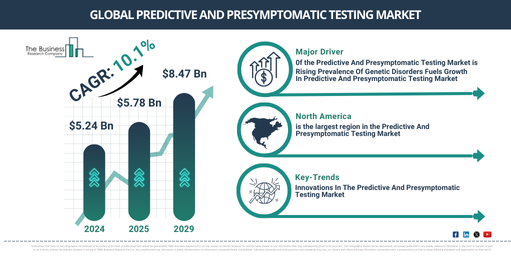Emerging Growth Drivers in the Gestational Diabetes Market Landscape: Impact Of Rising Obesity Rates On Healthcare Demand
Stay ahead with our updated market reports featuring the latest on tariffs, trade flows, and supply chain transformations.
How Has The Gestational Diabetes Market Size Shifted, And What Is the Outlook Through 2034?
The market size of gestational diabetes has seen considerable growth over the past few years, expanding from $8.37 billion in 2024 to a projected worth of $9.14 billion in 2025, indicating a compound annual growth rate (CAGR) of 9.3%. This growth experienced in the historic period can be linked to a variety of factors such as a heightened risk of diabetes, improved precision in blood glucose level measurement, a rise in the number of insurance providers, an increase in the population of patients with diabetes, and the overall growth of the diabetic population.
The market size of gestational diabetes is projected to experience robust growth in the forthcoming years, rising to $12.90 billion by 2029 with a compound annual growth rate (CAGR) of 9.0%. This growth during the forecast period can be ascribed to the escalating obesity rates, the growing acceptance of cloud-based project initiatives, the increasing use of associated devices and applications, heightened instances of diabetes owing to unhealthy lifestyle habits, greater public health awareness, and a surge in diabetes prevalence rates. Key trends predicted for the forecast period encompass digital diabetes management applications, closed-loop control systems, advanced diabetes management technology, enzymatic technology, and innovative medical technologies.
Download a free sample to assess the report’s scope and structure:
https://www.thebusinessresearchcompany.com/sample.aspx?id=20818&type=smp
Which Primay Drivers Are Accelerating Growth in the Gestational Diabetes Market?
The surge in the number of individuals with obesity is projected to boost the growth of the gestational diabetes market. The obese demographic comprises individuals with a body mass index (BMI) of 30 or more, implying excessive body fat which could lead to serious health issues. Rising obesity is due to a myriad of factors such as inactive lifestyles, high intake of high-calorie, processed foods, genetic factors, and restricted access to wholesome food and physical activity options. The treatment of gestational diabetes is vital for obese individuals as their elevated risk of insulin resistance and substantial weight increase during pregnancy could cause complications for both mother and child if not monitored. For example, in March 2024, as per the World Health Organization, a Switzerland-based international organization, approximately 1 in 8 individuals around the world were obese in 2022, with 2.5 billion adults aged 18 and over categorized as overweight, and 890 million categorized as obese. Among adults, 43% were overweight, and 16% were obese. Furthermore, 37 million children under age 5 were overweight, while over 390 million children and adolescents ranging from age 5-19 years were overweight, including 160 million who were obese. Consequently, the increasing obese population is stimulating the gestational diabetes market.
Which Primary Segments of the Gestational Diabetes Market Are Driving Growth and Industry Transformations?
The gestational diabetes market covered in this report is segmented –
1) By Types: Type A1, Type A2, Other Types
2) By Treatment: Monitoring, Drug Treatment, Non-pharmacological treatment
3) By Administration: Oral, Intravenous, Other Administrations
4) By End User: Hospitals, Clinics, Home Care Settings, Diagnostic Centers
Subsegments:
1) By Type A1: Diet-Controlled Gestational Diabetes, Exercise-Controlled Gestational Diabetes
2) By Type A2: Insulin-Controlled Gestational Diabetes, Oral Medication-Controlled Gestational Diabetes
3) By Other Types: Pre-Gestational Diabetes, Gestational Diabetes With Complications
Request customized data on this market:
https://www.thebusinessresearchcompany.com/customise?id=20818&type=smp
Which Regions Are Key Players in the Growth of the Gestational Diabetes Market?
North America was the largest region in the gestational diabetes market in 2024. Asia-Pacific is expected to be the fastest-growing region in the forecast period. The regions covered in the gestational diabetes market report are Asia-Pacific, Western Europe, Eastern Europe, North America, South America, Middle East, Africa.
What Long-Term Trends Are Transforming the Competitive Landscape of the Gestational Diabetes Market?
Key players in the gestational diabetes market are concentrating their efforts on creating products that incorporate advanced technology, such as diagnostic kits for gestational diabetes. These kits provide quick, accurate methods for early detection. They function as a medical device that gauges blood glucose levels and detects irregular glucose tolerance in expectant women, supporting early diagnosis and management of the condition. For example, in August 2024, a diagnostic kit known as XpressGT RUO was launched by DirectSens GmbH, a biotech firm based in Austria. This kit enables the diagnosis of conditions like gestational diabetes, endometriosis, insulin resistance, and liver disease by precisely tracking 2-hydroxybutyrate (2-HB) levels found in venous blood. This substance is naturally produced by the liver as part of its standard operations. Elevated levels of 2-HB correlate with increased reductive stress, which has been connected to a range of endocrine and obesity-related disorders, including insulin resistance. The diagnostic kit can be used on any clinical analyzer and produces results in only 8 minutes, making it a fast and effective diagnostic option.
View the full report here:
https://www.thebusinessresearchcompany.com/report/gestational-diabetes-global-market-report
What Parameters Are Used to Define the Gestational Diabetes Market?
Gestational diabetes is a type of diabetes that develops during pregnancy when the body cannot produce enough insulin to regulate blood sugar levels effectively. This condition typically occurs in the second or third trimester and can affect women who have no prior history of diabetes. Gestational diabetes poses risks to both the mother and baby, including high birth weight, preterm birth, and potential development of type 2 diabetes later in life for both. It is often managed through dietary adjustments, exercise, blood sugar monitoring, and sometimes insulin therapy to ensure a healthy pregnancy and delivery.
Purchase the full report and get a swift delivery:
https://www.thebusinessresearchcompany.com/purchaseoptions.aspx?id=20818
About The Business Research Company:
With over 15000+ reports from 27 industries covering 60+ geographies, The Business Research Company has built a reputation for offering comprehensive, data-rich research and insights. Armed with 1,500,000 datasets, the optimistic contribution of in-depth secondary research, and unique insights from industry leaders, you can get the information you need to stay ahead in the game.
Get in touch with us:
The Business Research Company: https://www.thebusinessresearchcompany.com/
Americas +1 3156230293
Asia +44 2071930708
Europe +44 2071930708
Email us at info@tbrc.info
Follow us on:
LinkedIn: https://in.linkedin.com/company/the-business-research-company
YouTube: https://www.youtube.com/channel/UC24_fI0rV8cR5DxlCpgmyFQ
Global Market Model: https://www.thebusinessresearchcompany.com/global-market-model



